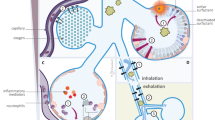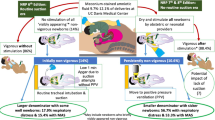Abstract
To determine characteristics, management, complications and outcome of neonates with meconium aspiration syndrome (MAS) requiring mechanical ventilation (MV). A retrospective review of clinical data of neonates with MAS who were admitted to a public hospital for MV between January 2004 and December 2006. Eighty-eight neonates were ventilated for MAS. Thirty-one percent were postdates and 51% had no electronic fetal monitoring. Postnatal suctioning of meconium was not performed according to protocol in 47% of nonvigorous infants. High-frequency ventilation and surfactant were used in 32 and 14% of cases, respectively. Persistent pulmonary hypertension of the newborn (PPHN) and pneumothorax occurred in 57 and 24% of cases, respectively. Overall mortality rate was 33%. Neonates suffering from MAS with PPHN had higher mortality rate of 48% compared with 13% in those suffering from MAS without PPHN. Factors associated with mortality were peak inspiratory pressure (P<0.001), pneumothorax (P<0.001) and PPHN (P=0.001). Postdates, inadequate intrapartum monitoring and limited use of adjunct respiratory therapies were common. Severe MAS is associated with adverse outcome.
This is a preview of subscription content, access via your institution
Access options
Subscribe to this journal
Receive 12 print issues and online access
$259.00 per year
only $21.58 per issue
Buy this article
- Purchase on Springer Link
- Instant access to full article PDF
Prices may be subject to local taxes which are calculated during checkout


Similar content being viewed by others
References
Wiswell TE, Tuggle JM, Turner BS . Meconium aspiration syndrome: have we made a difference? Pediatrics 1990; 85: 715–721.
Chinese collaborative study group for neonatal respiratory diseases. Treatment of severe meconium aspiration syndrome with porcine surfactant: a multicentre, randomized, controlled trial. Acta Paediatr 2005; 94: 896–902.
Carson BS, Losey RW, Bowes WA, Simmons MA . Combined obstetric and pediatric approach to prevent meconium aspiration syndrome. Am J Obstet Gynecol 1976; 126: 712–715.
Davis RO, Philips JB, Harris BA, Wilson ER, Huddelston JF . Fetal meconium aspiration syndrome occurring despite airway management considered appropriate. Am J Obstet Gynecol 1985; 151: 731–736.
Dargaville PA, Copnell B, for the Australian and New Zealand Neonatal Network. The epidemiology of meconium aspiration syndrome: incidence, risk factors, therapies and outcome. Pediatrics 2006; 117: 1712–1721.
Yoder BA, Kirsch EA, Barth Jr WH, Gordon MC . Changing obstetric practices associated with decreasing incidence of meconium aspiration syndrome. Obstet Gynecol 2002; 99: 731–739.
Mahomed K, Mulambo T, Woelk G, Hofmeyr J, Gulmezoglu AM . The collaborative randomized amnioinfusion for meconium project (CRAMP): 2. Zimbabwe. Br J Obstet Gynaecol 1998; 105: 309–313.
Greenough A, Pulikot A, Dimitriou G . Prevention and management of meconium aspiration syndrome—assessment of evidence based practice. Eur J Pediatr 2005; 164: 329–330.
Finer NN, Barrington KJ . Nitric oxide for respiratory failure in infants born at or near term. Cochrane Database Syst Rev 2006; 4: CD000399.
El Shahed AI, Dargaville P, Ohlsson A, Soll RF . Surfactant for meconium aspiration syndrome in full term/near term infants. Cochrane Database Syst Rev 2007; 3: CD002054.
Hernandez C, Little BB, Dax JS, Gilstrap LC, Rosenfeld CR . Prediction of the severity of meconium aspiration syndrome. Am J Obstet Gynecol 1993; 169: 61–70.
Kattwinkel J, Niermeyer S, Nadkarni V, Tibballs J, Phillips B, Zideman D et al. An Advisory Statement from the Pediatric Working Group of the International Liaison Committee on Resuscitation. Pediatrics 1999; 103: e56.
Wiswell TE, Bent RC . Meconium staining and the meconium aspiration syndrome. Pediatr Clin North Am 1993; 40: 955–981.
Liu WF, Harrington T . Delivery room risk factors for meconium aspiration syndrome. Am J Perinatol 2002; 19: 367–378.
Adhikari M, Gouws E, Velaphi SC, Gwamanda P . Meconium aspiration syndrome: importance of the monitoring of labor. J Perinatol 1998; 18: 55–60.
Clausson B, Cnattingius S, Axelsson O . outcomes of post-term births: the role of fetal growth restriction and malformations. Obstet Gynecol 1999; 94: 758–762.
Yoder B . Meconium-stained amniotic fluid and respiratory complications: impact of selective tracheal suction. Obstet Gynecol 1994; 83: 77–84.
Dooley S, Pesavanto D, Depp R, Socol M, Tamura R, Wiringa K . Meconium below the vocal cords at delivery: correlation with intrapartum events. Am J Obstet Gynecol 1985; 153: 767–770.
Rossi E, Philipson E, Williams T, Kalhan S . Meconium aspiration syndrome: intrapartum neonatal attributes. Am J Obstet Gynecol 1989; 74: 715–721.
Usta I, Mercer B, Sibai B . Risk factors for meconium aspiration syndrome. Obstet Gynecol 1995; 86: 230–240.
Flaciglia HS . Failure to prevent meconium aspiration syndrome. Obstet Gynecol 1988; 71: 349–353.
Cornish JD, Dreyer GL, Snyder GE, Kuehl TJ, Gerstmann DR, Null DM et al. Failure of acute perinatal asphyxia or meconium aspiration to produce persistent pulmonary hypertension in a neonatal model. Am J Obstet Gynecol 1994; 171: 43–49.
Thureen P, Hall DM, Hoffenberg A, Tyson RM . Fatal meconium aspiration in spite of appropriate perinatal airway management: pulmonary and placental evidence of prenatal disease. Am J Obstet Gynecol 1997; 176: 967–975.
Kojima T, Hattori K, Fujiwara T, Sasai-Takedatsu M, Kobayashi Y . Meconium-induced lung injury mediated by activation of alveolar macrophages. Life Sci 1994; 54: 1559–1562.
Coughtrey H, Jeffery HE, Henderson Smart DJ, Storey B, Poulos V . Possible causes linking asphyxia, thick meconium, and respiratory distress. Aust N Z J Obstet Gynaecol 1991; 31: 97–102.
Wiswell TE, Henley MA . Intratracheal suctioning, systemic infection, and the meconium aspiration syndrome. Pediatrics 1992; 89: 203–206.
Perlman EJ, Moore GW, Hutchins GM . The pulmonary vasculature in meconium vasculature in meconium aspiration. Hum Pathol 1989; 20: 701–706.
Murphy ID, Vawter GF, Reid LM . Pulmonary vascular disease in fatal meconium aspiration. J Pediatr 1984; 104: 158–162.
Author information
Authors and Affiliations
Corresponding author
Additional information
Disclosure
The authors have declared no financial interests.
Rights and permissions
About this article
Cite this article
Velaphi, S., Van Kwawegen, A. Meconium aspiration syndrome requiring assisted ventilation: perspective in a setting with limited resources. J Perinatol 28 (Suppl 3), S36–S42 (2008). https://doi.org/10.1038/jp.2008.155
Published:
Issue Date:
DOI: https://doi.org/10.1038/jp.2008.155
This article is cited by
-
Persistent pulmonary hypertension of the newborn
Maternal Health, Neonatology and Perinatology (2015)
-
Tracheal suctioning improves gas exchange but not hemodynamics in asphyxiated lambs with meconium aspiration
Pediatric Research (2015)
-
Blood lactate level and meconium aspiration syndrome
Archives of Gynecology and Obstetrics (2015)



